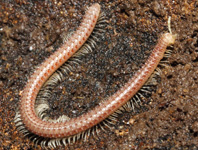Abstract
Suphisellus epleri sp. nov. is described from Veracruz, Mexico. The new species is characterized by (1) size; (2) elytra brownish-red, moderately punctate, each with three light-yellow spots; and (3) aedeagus with median lobe curved with width nearly uniform along its length. In appearance, S. epleri is very similar to S. neglectus Young 1979 with which it is here compared based on specimens collected from Colombia and Venezuela. Suphisellus epleri is distinguished by having a slightly broader anterior extremity of prosternal process and a slender median lobe that is not distinctly expanded at apex, as in S. neglectus. The first record of S. neglectus in Venezuela is also reported. Descriptions, images and illustrations of diagnostic characters, and differential diagnosis of S. epleri are provided.
References
Arce-Pérez, R. & Roughley, R.E. (1999) Lista anotada y claves para los Hydradephaga (Coleoptera: Adephaga: Dytiscidae, Noteridae, Haliplidae, Gyrinidae) de México. Dugesiana, 6 (2), 69–104.
Aubé, C. (1836–1838) Hydrocanthares. In: Dejean, P.F. (Ed.), Iconographie et histoire naturelle des coléoptères d’Europe. Vol. 5. Méquignon-Marvis, Paris, pp. 1–416.
Baca, S.M. & Toledo, M. (2015) Canthysellus Baca and Toledo (Coleoptera: Noteridae: Noterini), a new genus of burrowing water beetle from South America. The Coleopterists Bulletin, 69 (3), 477–488.
https://doi.org/10.1649/0010-065X-69.3.477Baca, S.M. Toussaint, E.F.A., Miller, K.B. & Short, A.E.Z. (2017) Molecular phylogeny of the aquatic beetle family Noteridae (Coleoptera: Adephaga) with an emphasis on partitioning strategies. Molecular phylogenetics and Evolution, 107, 282–292.
https://doi.org/10.1016/j.ympev.2016.10.016Balfour-Browne, J. (1939) A contribution to the study of the Dytiscidae. -I. (Coleoptera, Adephaga). The Annals and Magazine of Natural History, Series 11, 3, 97–114.
Belkaceme, T. (1991) Skelet und Muskulatur des Kopfes und Thorax von Noterus laevis Sturm. Ein Beitrag zur Morphologie und Phylogenie der Stuttgarter Beiträge zur Naturkunde, Serie A (Biologie), 492, 1–94.
Beutel, R.G., Balke, M. & Steiner, W.E. Jr. (2006) The systematic position of Meruidae (Coleoptera, Adephaga) based on a cladistics analysis of morphological characters. Cladistics, 22, 102–131.
https://doi.org/10.1111/j.1096-0031.2006.00092.xBrug-Aguilar, B. (2010) Ensamblaje de larvas de Odonata (Insecta) en la Laguna de Miradores, Municipio de Emiliano Zapata, Veracruz, Mexico. Master in Science Thesis. Instituto de Ecología, A.C., Xalapa, 158 pp.
CETENAL, UNAM (1970) 1970 CETENAL-UNAM Carta de climas. Veracruz, 14Q-IV, Comisión de planeación. Comisión de Estudios del Territorio Nacional-UNAM. Instituto de Geografía, Escala 1:500,000. Secretaria de la Presidencia, México.
CRaEC (2015) Collections Resourcres for Aquatic Coleoptera. Version 1.5. Online collections database managed by the Short Lab Research Group, University of Kansas Biodiversity Institute. Available from: http://creac.kubiodiversityinstitute.org/collections (accessed 16 June 2017)
Crotch, G.R. (1873) Revision of the Dytiscidae of the United States. Transactions of the American Entomological Society, 4, 383-424.
Dressler, C., Ge, S.-Q. & Beutel, R.G. (2011) Is Meru a specialized noterid (Coleoptera: Adephaga)? Systematic Entomology, 36, 705–712.
https://doi.org/10.1111/j.1365-3113.2011.00585.xGarcía, M., Benetti, C. & Camacho, J. (2012) A new species of Suphisellus Crotch, 1873 (Coleoptera: Noteridae) from “Los Llanos”, Venezuela. Zootaxa, 3298, 62–68.
Horn, G.H. (1871) Descriptions of new Coleoptera of the United States, with notes on known species. Transactions of the American Entomological Society, 3, 325–344.
Miller, K.B. (2001) Hydrocanthus (Hydrocanthus) paludimonstrus, a new species from Bolivia (Coleoptera: Noteridae: Hydrocanthini) and its implications for classification of the subgenera. The Coleopterists Bulletin, 55, 363–368.
https://doi.org/10.1649/0010-065X(2001)055[0363:HHPANS]2.0.CO;2Miller, K.B. (2009) On the systematics of Noteridae (Coleoptera: Adephaga: Hydradephaga): Phylogeny, description of a new tribe, genus and species, and survey of female genital morphology. Systematics and Biodiversity, 7 (2), 191–214.
https://doi.org/10.1017/S1477200008002946Miller, K.B. & Nilsson, N.A. (2003) Homology and terminology: Communicating information about rotated structures in water beetles. Latissimus, 17, 1–4.
Nilsson, A.N. (2011) A World Catalogue of the family Noteridae, or the Burrowing water beetles (Coleoptera: Adephaga). Version 16. VIII. 2011, 54 pp. Available from: http://www2.emg.umu.se/projects/biginst/andersn/WCN/WCN_20110816.pdf (accessed 16 February 2017)
Say, T. (1823) Descriptions of insects of the families of Carabici and Hydrocanthari of Latreille, inhabiting North America. Transactions of the American Philosophical Society, 2 (1825), 1–109.
https://doi.org/10.2307/1005051Sharp, D. (1882) On aquatic carnivorous Coleoptera or Dytiscidae. Scientific Transactions of the Royal Dublin Society, 2, 179–1003.
Young, F.N. (1979) Water beetles of the genus Suphisellus Crotch in the Americas north of Colombia (Coleoptera: Noteridae). The Southwestern Naturalist, 24 (3), 409–429.
https://doi.org/10.2307/3671297

